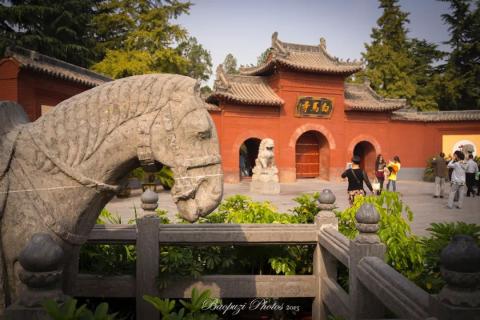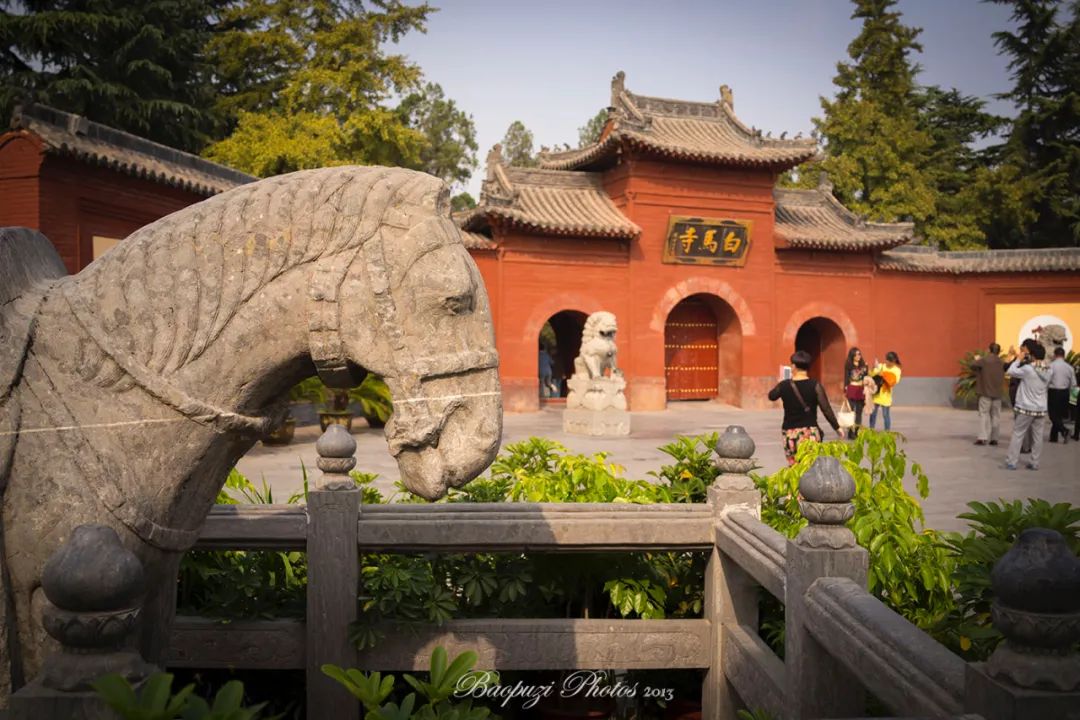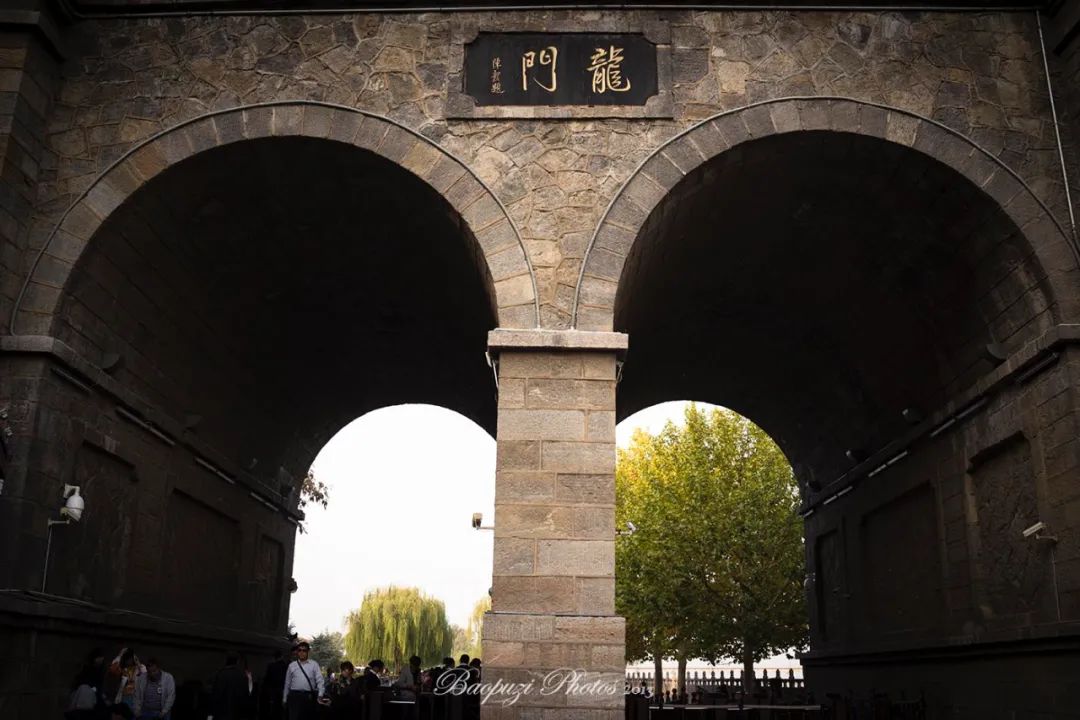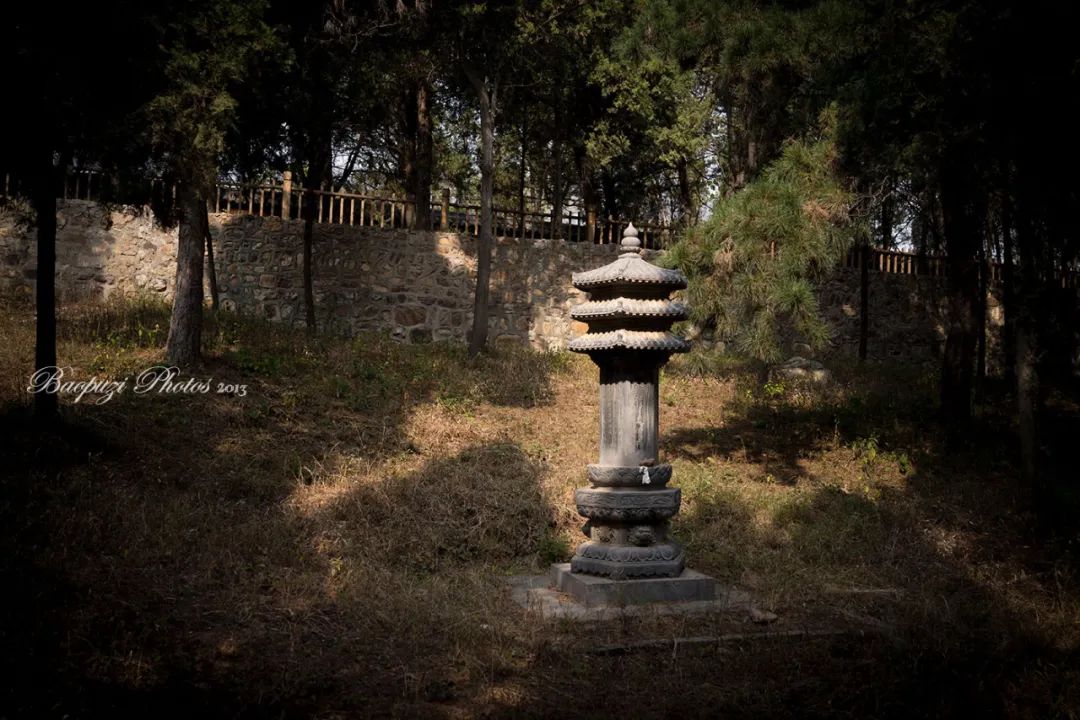
Antes de venir al Templo del Caballo Blanco, también había estado en algunos templos. Aunque también conozco la importancia del Templo del Caballo Blanco, sólo me quedo en el nivel de comprensión. Pero cuando vine aquí, realmente sentí que el nombre de "El Primer Templo de la Corte Ancestral" era bien merecido.

Según la leyenda, el emperador Ming de la dinastía Han, Liu Zhuang, "dormía en Nangong por la noche y soñaba que la cabeza del dios dorado brillaba con una luz blanca y volaba por el palacio". Al día siguiente, se enteró de que el sueño era Buda, por lo que envió enviados Cai Yin, Qin Jing y otros a las regiones occidentales para orar por las enseñanzas budistas.
Más tarde, dos eminentes monjes indios, Zhu Falan y Shemo Teng, fueron invitados a Luoyang y trajeron escrituras budistas y estatuas de Buda transportadas en caballos blancos.
Al año siguiente, el emperador Ming de la dinastía Han ordenó la construcción del Templo del Caballo Blanco para conmemorar la llegada del budismo llevado por el caballo blanco a las Llanuras Centrales.
Desde entonces, existe el primer templo antiguo de China. Por supuesto, también se encuentra el mundialmente famoso Jialan, conocido como la "corte ancestral" y la "fuente del budismo" en China.
 La puerta del templo Baima es simple y solemne. Las paredes rojas y los azulejos verdes revelan la riqueza de la historia. Un par de leones de piedra y un par de caballos de piedra se encuentran a izquierda y derecha.
La puerta del templo Baima es simple y solemne. Las paredes rojas y los azulejos verdes revelan la riqueza de la historia. Un par de leones de piedra y un par de caballos de piedra se encuentran a izquierda y derecha.
 Hay un quemador de incienso frente al Gran Salón del Buda. Es de color negro, está tallado con patrones y tiene una forma muy simple y elegante.
Hay un quemador de incienso frente al Gran Salón del Buda. Es de color negro, está tallado con patrones y tiene una forma muy simple y elegante.

El incienso en el Templo Baima es muy popular. En aquellos días, había un lugar de incienso gratuito frente a la Torre del Tambor y también se colocaba incienso en los carteles en la entrada de muchos salones para que los fieles lo tomaran de forma gratuita. Debido a la situación en la que se vende incienso de alta gama en muchos templos, la gente se siente respetada.
 Hay una piedra parecida a un melocotón entre el Salón Principal y el Gran Salón del Buda. Era la cima de una pagoda en la dinastía Han. Se dice que tocarla puede aumentar la felicidad y la longevidad. Al observar lo suave y brillante que es, puedes saber cuántas personas lo tocan todos los días.
Hay una piedra parecida a un melocotón entre el Salón Principal y el Gran Salón del Buda. Era la cima de una pagoda en la dinastía Han. Se dice que tocarla puede aumentar la felicidad y la longevidad. Al observar lo suave y brillante que es, puedes saber cuántas personas lo tocan todos los días.

 Fotografié a un monje leyendo las Escrituras dentro del templo.
Fotografié a un monje leyendo las Escrituras dentro del templo.
 Hay otro monje que está pensando.
Hay otro monje que está pensando.

 Cualquiera que haya visitado las Grutas de Longmen en Luoyang quedará impactado por la majestuosidad de las estatuas de Buda en las cuevas. Entre ellos, el Nicho de la Gran Estatua de Lushena es el más próspero. Tiene una historia de más de 1.300 años y todavía luce solemne y amable.
Cualquiera que haya visitado las Grutas de Longmen en Luoyang quedará impactado por la majestuosidad de las estatuas de Buda en las cuevas. Entre ellos, el Nicho de la Gran Estatua de Lushena es el más próspero. Tiene una historia de más de 1.300 años y todavía luce solemne y amable.
 Históricamente, Luoyang fue la capital de la dinastía Han del Este, la dinastía Wei del Norte, la dinastía Wuzhou y otras dinastías. Durante la dinastía Han del Este, el budismo comenzó a introducirse en China y fue el centro de la cultura Han. Los emperadores de la dinastía Wei del Norte generalmente defendían el budismo, pero Wu Zetian creía en el budismo aún más. Para mostrar su devoción al Buda, estas dinastías construyeron muchos proyectos de construcción en Luoyang, y las Grutas de Longmen son las más famosas.
Históricamente, Luoyang fue la capital de la dinastía Han del Este, la dinastía Wei del Norte, la dinastía Wuzhou y otras dinastías. Durante la dinastía Han del Este, el budismo comenzó a introducirse en China y fue el centro de la cultura Han. Los emperadores de la dinastía Wei del Norte generalmente defendían el budismo, pero Wu Zetian creía en el budismo aún más. Para mostrar su devoción al Buda, estas dinastías construyeron muchos proyectos de construcción en Luoyang, y las Grutas de Longmen son las más famosas.

 Hay más de 1.300 cuevas, 2.345 cuevas budistas y nichos budistas, más de 50 pagodas y más de 100.000 estatuas de Buda en las Grutas de Longmen. La estatua de Buda más grande tiene 17,14 metros de altura y la más pequeña mide sólo 2 centímetros. son los más representativos.
Hay más de 1.300 cuevas, 2.345 cuevas budistas y nichos budistas, más de 50 pagodas y más de 100.000 estatuas de Buda en las Grutas de Longmen. La estatua de Buda más grande tiene 17,14 metros de altura y la más pequeña mide sólo 2 centímetros. son los más representativos.





De pie en el lado opuesto y mirando a su alrededor, hay grutas grandes y pequeñas talladas en el acantilado, al igual que nichos budistas, que originalmente deberían contener exquisitos murales y estatuas de Buda. Quizás debido al bautismo del tiempo o a la destrucción por parte de los ladrones, el gran Buda en el nicho ahora está incompleto. Pero cuando los veo, no puedo evitar sentir asombro por los antiguos. Tomemos como ejemplo el tamaño de la estatua de Buda. Hoy no nos sorprende el edificio de 100 metros de altura, sino hace miles de años. Cuando vimos la altura de la estatua de Buda Lushena, nos quedamos con una admiración infinita en términos de la belleza de la estatua de Buda, la luz de fondo de la estatua de Buda (es decir, la abertura detrás de la estatua de Buda); Es como una llama ardiente, saltando constantemente, mostrando un poder supremo. El rostro del Buda es pacífico y solemne, sonriente pero no sonriente, y contiene un significado profundo infinito, al igual que el "Sutra del Diamante" habla de todas las apariencias y; ¡faltas de apariencias!

 El Templo Shaolin comenzó en las Dinastías del Norte y del Sur después de los Tres Reinos y la Dinastía Jin. Durante el período del Emperador Xiaowen de la Dinastía Wei del Norte en el año 495 d.C., eminentes monjes indios de Occidente vinieron a enseñar budismo y construyeron un templo en Shaolin. Montaña cerca de Luoyang, la capital.
El Templo Shaolin comenzó en las Dinastías del Norte y del Sur después de los Tres Reinos y la Dinastía Jin. Durante el período del Emperador Xiaowen de la Dinastía Wei del Norte en el año 495 d.C., eminentes monjes indios de Occidente vinieron a enseñar budismo y construyeron un templo en Shaolin. Montaña cerca de Luoyang, la capital.
La montaña Songshan y el templo Shaolin están actualmente bajo la jurisdicción de Zhengzhou. Dengfeng originalmente pertenecía a Luoyang y fue colocado bajo Zhengzhou después de la fundación de la República Popular China. Sin embargo, la fama y la historia de la montaña Songshan y el templo Shaolin son inseparables de Luoyang. El verso en la puerta de la Academia Songyang dice: "Cerca de los cuatro lados están el Gobierno Central, Taihua, Hengheng, los Cuatro Mares, el Río Guanhe y la Montaña Shenshan. A través de las nueve dinastías, ha sido la ciudad, incluida Yizhen , Luojian, tres vientos y lluvia, y las montañas ". La ciudad de las Nueve Dinastías se refiere a la ciudad. Luoyang, Yishan y Luojian son los cuatro ríos en Luoyang; el centro se refiere a Luoyang en el mundo; se construyó el Templo Shaolin durante el reinado del emperador Xiaowen. Por lo tanto, todavía clasifico el Templo Shaolin en el capítulo de Luoyang.

 Espectáculo de artes marciales Shaolin.
Espectáculo de artes marciales Shaolin.






 Los extranjeros no son una excepción y se toman fotografías frente a la estatua de Bodhidharma.
Los extranjeros no son una excepción y se toman fotografías frente a la estatua de Bodhidharma.
 Después de que Bodhidharma, un discípulo de Sakyamuni, llegó al templo, practicó en una cueva, que tenía solo un pie cuadrado. Las generaciones posteriores llamaron abad al abad del templo Shaolin.
Después de que Bodhidharma, un discípulo de Sakyamuni, llegó al templo, practicó en una cueva, que tenía solo un pie cuadrado. Las generaciones posteriores llamaron abad al abad del templo Shaolin.

 A unos 300 metros al oeste del templo Shaolin se encuentra también el bosque de pagodas más grande de China. Lo que es muy ventajoso es que limita con Shaoxi al sur, Longhu Ridge al fondo, Niu Mountain Range al este y Dangyangpo al oeste. El paisaje allí es muy hermoso y es la tumba de los eminentes monjes y abades de Shaolin. .
A unos 300 metros al oeste del templo Shaolin se encuentra también el bosque de pagodas más grande de China. Lo que es muy ventajoso es que limita con Shaoxi al sur, Longhu Ridge al fondo, Niu Mountain Range al este y Dangyangpo al oeste. El paisaje allí es muy hermoso y es la tumba de los eminentes monjes y abades de Shaolin. .


Lectura relacionada:
El Beijing que fotografié en esos años: Dashilan, Imperial College y Feria del Templo Ditan
Las ciudades mágicas que fotografié en esos años: el Bund, los callejones y Zhujiajiao
El sur de Xinjiang que fotografié en esos años: el lago Baisha, el pico Muztage y las casas residenciales Gaotai.
El norte de Xinjiang que fotografié en esos años: Nalati Grassland, Sailimu Lake y Hemu Village
El Yangzhou que fotografié en esos años: Slender West Lake, antiguo canal, jardines y otros
El Huizhou que fotografié en esos años: paredes rosas y azulejos negros, el Arco Tangyue y el río Xin'an
La Lhasa que fotografié en esos años: Magyami, Monasterio de Drepung y Palacio Potala
Las montañas Siguniang que tomé en esos años: montañas nevadas, prados y playas de árboles muertos
La aldea tibetana de Jiaju que fotografié en esos años: las montañas, la aldea y la gente.
Kasumigaura que fotografié en esos años.
Las garcetas que fotografié en aquellos años
Las flores de colza que fotografié en esos años
